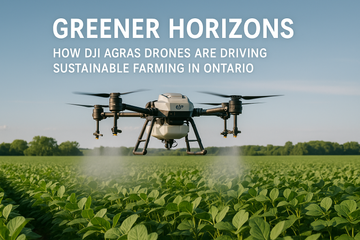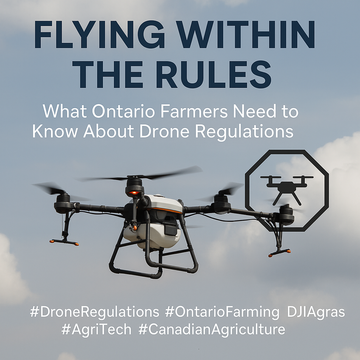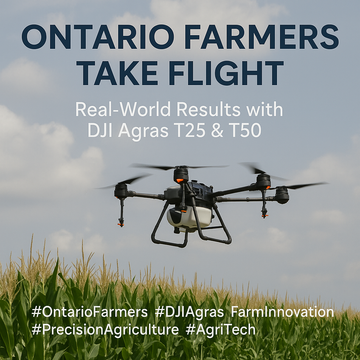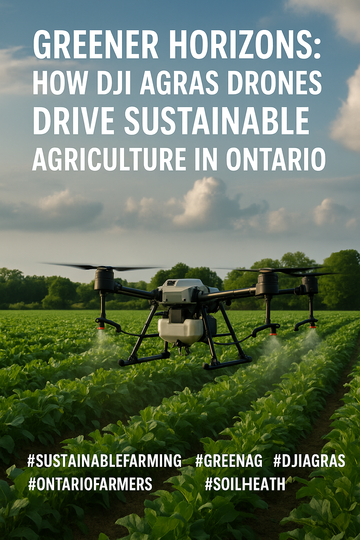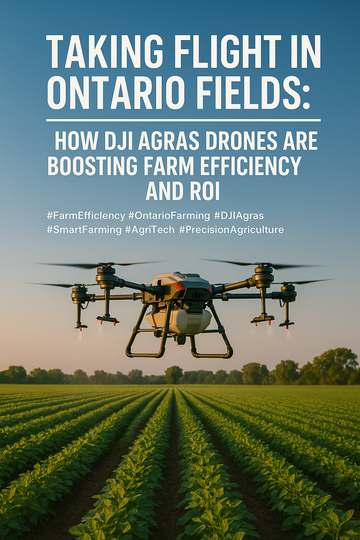Ontario Agriculture Meets Sustainability
Ontario farmers face dual pressures: feeding a growing population and protecting the environment. Climate change, soil degradation, and regulatory demands all add urgency. Drones like the DJI Agras T25 and T50 are emerging as allies, offering precision agriculture tools that align efficiency with sustainability.
Precision Spraying: Less Waste, Less Runoff
One of the biggest environmental challenges in Ontario farming is nutrient and pesticide runoff into waterways like the Great Lakes. The Agras series addresses this with:
-
Variable Droplet Control: Ensures chemicals are applied in exactly the right amounts.
-
Targeted Spraying: Reduces overspray, preventing chemicals from reaching non-target areas.
-
Data Integration: Mapping and AI features allow farmers to apply inputs where needed most, cutting waste.
The result: fewer chemicals entering waterways, supporting Ontario’s environmental goals.
Protecting Ontario’s Soil and Crops
Traditional ground sprayers can compact soil and damage growing plants. The Agras drones eliminate these problems:
-
No Wheel Tracks: Crops stay intact, maximizing yield.
-
Reduced Compaction: Healthier soil structure leads to better water absorption and nutrient availability.
-
Improved Accessibility: Farmers can treat fields even when soils are saturated, avoiding machinery damage.
Energy & Fuel Efficiency
Switching from diesel-powered rigs to electric drones offers a clear sustainability win:
-
Lower Carbon Emissions: Each drone mission consumes a fraction of the fuel of a tractor-run sprayer.
-
Reduced Noise & Pollution: Electric motors are quieter and cleaner, aligning with rural community expectations.
Over a season, Ontario farms can save thousands of liters of fuel—shrinking their carbon footprint while cutting costs.
Supporting Climate Resilience
Ontario’s weather can be unpredictable. Drones help farmers adapt:
-
Quick Deployment: Spray when a short weather window opens.
-
Reduced Input Dependency: More precise application lowers reliance on chemicals.
-
Data-Driven Insights: Field mapping allows proactive responses to pest or disease pressure.
This flexibility supports both productivity and long-term resilience.
Navigating Ontario’s Regulations
Sustainability also means compliance. For now:
-
T25 and T50 require registration and advanced pilot certification.
-
Commercial spraying still requires an SFOC-RPAS, as pesticide labels in Canada are only beginning to recognize drones.
-
Granular spreading and non-pesticide spraying are currently the most practical sustainable applications.
Farmers adopting drones today position themselves ahead of the regulatory curve.
A Greener Future for Ontario Farming
The DJI Agras T25 and T50 don’t just promise efficiency—they’re tools for sustainable intensification, helping Ontario farmers grow more with less impact. By reducing chemical runoff, preventing soil damage, and lowering fuel consumption, drones align with both economic and environmental goals.
The future of farming in Ontario isn’t just about bigger yields—it’s about farming smarter, cleaner, and greener. And drones are helping make that vision a reality.
#SustainableFarming #DJIAgras #OntarioFarming #PrecisionAg #GreenAgriculture #DroneFarming #AgriTech #SmartFarming #SoilHealth #CanadianAgriculture #FarmInnovation #ClimateSmartAg


